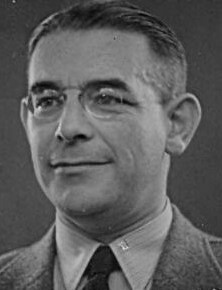Search for Names, Places and Biographies
Already layed Stumbling Stones
Suche
Dr. Rudolf Borgzinner * 1896
Schäferkampsallee 29 (Eimsbüttel, Eimsbüttel)
1943 Theresienstadt/Auschwitz
ermordet 5.12.1944 KZ Dachau
further stumbling stones in Schäferkampsallee 29:
Martha Dessen, Heinrich Harth, Meyer Jelinewski, Margaretha Magnus, Eva Emma Mathiason, Gertrud Stillschweig, Clara Streim, Emma Weiland
Dr. Rudolf Borgzinner, born 17.4.1896 in Hamburg, deported 23.6.1943 to Theresienstadt, further deported on 27.10.1944 to Auschwitz, died on 5.12.2014 in the Dachau-Kaufering Concentration Camp
Schäferkampsallee 29 / Bramfelder Straße 23, Barmbek
The unmarried Doctor Rudolf Borgzinner was the only child of his parents Dr. med. Paul (born 1868 in Paderborn) and Minna Borgzinner, maiden name Kempenich (born 1869 in Neheim, died 1942). The parents lived in Husumer Straße 16 II. The medical practice of the father was in Bramfelder Straße 5. When Rudolf was born, the parents lived in Bramfelder Straße 22. When Paul Borgzinner left the German-Israeli Congregation in 1926, his wife and his son remained members. Rudolf Borgzinner after his pre-school phase from Michaelis 1905 to August 1914 was a pupil at the secondary school in Uhlenhorst and commenced his medical studies after completing his high school certificate "Abitur”. In the winter of 1914/1915 he was based in Kiel, commencing his medical studies in Würzburg in the summer of 1915. He had to interrupt his medical studies because of the First World War and did his military service between the autumn of 1915 and January 1919 in various infantry regiments. In February 1919 he recommenced his medical studies in Hamburg and passed his preliminary examination in the spring of 1920 in Würzburg. He completed the clinical phase of his studies in Munich and Hamburg, where he graduated in 1922. During the holiday period he undertook practical work in the pathological institute on the second ward of the internal medicine section of the Barmbek General Hospital where he completed his probationary year starting in January 1923. In 1923 he was awarded his medical certificate to practise as a doctor. In October 1923 he submitted his 27-page dissertation with the title "Über Pneumatosis cystoides intestini hominies" at the medical faculty of the University of Hamburg. His examiner was Theodor Fahr of the Pathological Institute of the Barmbek General Hospital. The dissertation dealt with the seldom-occurring symptoms of cysts containing gas in the wall of the intestines. Rudolf Borgzinner was a surgeon and worked as a junior physician in the Barmbek General Hospital until December 1932. Following this phase he assisted his father in his practice for a short period. In 1933 he was put in charge of the surgical ward of the Israeli Hospital. A contemporary witness was able to report that Rudolf Borgzinner, together with his Jewish colleague Eugen Kohn, functioned as an obstetrician at his birth in the Freemasons Hospital in Klein Schäferkamp. Whether Rudolf B. worked in this hospital for an extended period of time is unclear. It is likely that he was called in to assist as a surgeon because an expecting mother, a patient of his father Paul Borgzinner, was having complications with the birth. As a result the parents of the contemporary witness and the two doctors became friends.
From 1940 onwards Borgzinner was in charge of the surgery section of the Israeli Hospital with special permission to work as a Jewish doctor for the diseased. At that time the hospital on the Eckernförder Straße (today Simon-von-Utrecht Straße) in St.Pauli had to give up its location and move to the Siloah-Dioakonissen House in Johnsallee 68 / corner of Schlüterstraße. In 1942 the hospital had to move to the former Jewish Siechenheim in Schäferkamps Allee, which meant that with each move the hospital was reduced in size.
A co-worker at that time remembers Rudolf Borgzinner, whom she worked with in Schäferkamps Allee and became a good friend of his. She had also completed her medical studies, but as a Jew she was not allowed to work as a doctor. Up to the time of her emigration she worked as a hospital orderly. There were only five Jewish doctors active in 1942, most of them having a mixed marriage, which allowed them a certain measure of protection. Rudolf Borgzinner was the only surgeon und most probably the only doctor with a wealth of clinical experience. Rudolf Borgzinner informed his co-workers that an old friend of his was prepared to hide him in Barmbek, but he replied that he couldn’t accept this offer. The doctor and the hospital orderly had arranged to use a code word, in this case a second first name when addressing her, designed to inform the orderly who had already emigrated, when he would be transported. One day she in fact received such a postcard in which he informed her in code about his deportation. Rudolf Borgzinner was deported from Schäferkamps Allee to Theresienstadt on 23 Jun. 1943 and subsequently transported to Auschwitz on 28 Sep. 1944. There he was "selected” for hard labour and died in the Dachau concentration camp on 5 Dec. 1944 in the adjoining camp of Kaufering. He would appear to have been a collector of books. His library with about 800 books and volumes were auctioned off. The sum of 261,20 RM was transferred to the main tax office account in Hamburg.
Translator: Peter Huggett
Kindly supported by the Hermann Reemtsma Stiftung, Hamburg.
© Recherche und Text: Carmen Smiatacz und Susanne Lohmeyer
Quellen: 1; 2 (R 1940/86; R 1940/88); 4; 5; 7; WdE/FZH Aliasname: Elke Petsch, Teil 1 vom 24.6.1994 autorisierte Fassung; Auskunft der KZ-Gedenkstätte Dachau; StaH 214-1 Gerichtsvollzieherwesen 174 Dr. Rudolf Borgzinner; StaH 741-4, D 1174/36; StaH 332-5 Geburten 6352 u. 1154/1896; StaH 741-4, D 1174/36; Anna von Villiez, Mit aller Kraft verdrängt.; Denkmalpflege Hamburg, Nr. 5/Mai 1991, Das ehemalige Israelitische Krankenhaus; Rahlstedter Jahrbuch für Geschichte und Kultur 2011, S. 14; Israelitisches Krankenhaus in Hamburg – 175 Jahre, hrsg. von Harro Jenss u.a., Hamburg 2016, S. 69 ff.


